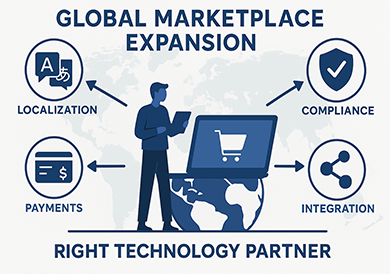
Do your clients want to integrate their software products with your API? And do you feel like you don’t have enough resources to provide API integration services yourself? Here’s the solution—you definitely need a third-party API integration partner.
If you’re now wondering about the scope of API integration partnerships worldwide, you can be surprised to hear that 56% of tech connoisseurs believe that APIs positively affect product enhancement. Moreover, international companies who have already implemented API integration in business confirm the 12.7% rise in market capitalization compared to those who haven’t.
The only nuance is to choose reliable API integration partners, which will help your business grow. And that’s what we’re going to dwell on in today’s piece—just take your time to read it.
The role of APIs in software development
In short, API bridges the communication between different systems, being the common language they understand. Literally, it takes the information from one source (let’s say a website) and takes it to the other, saving development time and effort to a great extent.
APIs can be public (for anyone), private (for authorized users), and partner (with terms & conditions on usage). To integrate your solutions with the latter, you need API integration specialists, and Patternica can help you with this task through our custom API integrations.
Who is the third-party API integration partner?
Understanding the basics is important. That’s why let’s enter our discussion step by step.
What is an integration partner? That’s the company you hire to work in tandem in order to build the liaison between your company’s software (or system) with the other company’s one. The API integration partner here is the third-party provider, another member of the team, whose development efforts result in building these API partnership connections.
Hmmm, what is a partner integration then? Well, let’s explain this with the example to put it more clearly. Imagine you’re an e-commerce company, and you’d like to build an integration partnership with the payment firm to allow your customers to pay for your goods without leaving a site. In this case, you hire a third-party integration partner for a custom API building, whose job is to get it technically done.
Why do you need an integration partner?
Now that you’ve grasped the key terms, let’s speak about the cases when you need to resort to the integration partner’s help. Though this list might be long, we’d like to focus on two key scenarios:
1. You want to integrate your software product with the third-party API
2. You’re more willing to connect your clients to your API.
After you see to what camp you belong, it’s time to thoroughly think about the API integration partnership as the best strategy you can take.
What value do you get from an integration partner?
We’re gradually coming to the question of how the other business integration partners can help you with API-building services.
Better customer service
Don’t ever underestimate the power of your customer service as it’s normally the prerequisite of service popularity as well as sales. So, if you want to work harder on this, the third-party API integrations can help you automate the process and take it to a new level of customer satisfaction.
Higher customer retention
Well, that’s actually the consequence of the previous point. Usually, it works this way: you invest in customer service > customers’ satisfaction rate increases > they become more loyal to your brand > you get more sales. If this all makes sense to you, building an API integration will be the right path.
Faster business scaling
Probably each business dreams of quick and solid growth steps, but not all of them are pretty sure how to achieve this. Our expert solution is to drive more customers and revenue through API integrations, saving time for the other business tasks you’re good at.
In-depth industry partnerships
Another bonus you can get together with third-party API integrations is the expansion of your industry relationships. Which way? By establishing business ties with other companies and improving your service, you also create a win-win partnership that strengthens each party’s market reach and revenue indices.
Сriteria for selecting the right API integration provider
You know WHAT FORs, and we’ll get you through HOWs. Ready? Let’s look at the core of the question—how to choose the professional software partner able to do the API integration job qualitatively.
✅ Access the value you expect to get. You already have an understanding of what it can be, but this time think closer about your project specifics.
✅ Place yourself in the user’s shoes. In other words, realize how this integration will facilitate your users’ lives, and in turn, help your company.
✅ Evaluate the size of the shared customer base. This number can also be a good indicator to measure the value this partnership can bring to your business.
Anything else? Consider the technical part of the question, logically moving to the next section.
Interested in expert API integration assistance?
Contact UsWhat are the technical requirements to participate in an integration partnership?
Though these technical details can depend on the type of partnership and the technologies used, you still need to pay attention to the proper documentation behind the APIs. This is essential for the seamless data sharing between the two (or more) systems and the easy support of this integration achievement. Hence, ask your potential partner to show understandable documentation so as not to worry about further performance.
Tips on researching potential partners
The last but not the least thing to help you with is the collection of small (but not in significance!) nuances to mind during your choice of the tech partner.
✅ Set clear goals. To be on the same page with your API integration partner, you first need to decide on these goals yourself.
✅ Do research. Yes, this takes time, but think about more time expenses in case you choose the non-relevant one.
✅ Define the terms of collaboration. Do it to mitigate risks and prevent money loss for any redundancy.
✅ Proceed with the pilot test: It’s wise to test the integration at the initial stage instead of bringing serious changes to it afterwards.
✅ Promote the new solution. Once the integration is done, introduce this new integration in marketing cycles to attract more attention to your upgraded software product.
Common integration partnership challenges
Teaming up with other companies to make your products or services work together can be a bit of a rollercoaster. Here are some of the bumps you might encounter along the way:
Endless negotiations
Figuring out the details of a partnership can take forever, especially when both sides have different ideas.
Tech troubles
Making sure all the different systems play nicely together can be a real puzzle that needs some serious tech know-how.
API headaches
APIs, those bridges between systems, can be tricky to navigate. They're always changing, which can cause some headaches.
The cost of integration
These projects can get pricey, especially if you need to build something unique.
Growing pains
As your business expands, your integration needs will likely change. It's important to build partnerships that can grow with you..
Data dilemmas
Inconsistent data can throw a wrench in the works.
Security risks
Connecting multiple systems can open doors for hackers, so security is a top priority.
Knowing about these challenges helps businesses prepare better. You can then take steps to avoid problems and make sure the partnerships are successful.
What payment API integration options can Patternica offer you?
Payment API integration involves connecting your application to third-party payment processors via secure APIs to enable online transactions, manage settlements, and handle customer payments seamlessly.
With years of hands-on experience building and maintaining payment integrations, Patternica has delivered robust, scalable solutions across industries.
We’re ready to help you integrate payment API into a website and provide complete technical support. But in case you need to choose a third-party payment API first, check the list of leaders in the market below.
1. Braintree
You’ve probably heard about this Chicago-based company bought by PayPal in 2013. Their primary target is e-commerce companies seeking the opportunity to safely accept and process web and mobile payments. Braintree’s payment gateway does just that, giving a free trial, multicurrency support, 24/7 customer support, and fraud detection functionality. The clear-cut UX, absence of hidden fees, and simple checkout are the things that made its name among businesses of all sizes.
2. Stax
It’s another American B2B payment gateway provider that serves small and midsize organizations that aim to facilitate accounting. Founded in 2014, the company still keeps its place in the fintech market, cutting down credit card processing fees and improving invoicing. Moreover, with Stax, you’ll pay only for the features your business needs, such as elaborate dashboards or a dedicated accountant’s help.
3. Stripe
Despite its American-Irish roots, this payment processing partner is much talked about worldwide. Its popularity is due to a vast selection of APIs and a focus on in-person payments through terminals. Altogether, this perfect blend gives much flexibility in customizing a payment gateway per your business needs.
4. Square
Compared to Stripe, Square offers lower transaction costs and a more convenient tool for processing payrolls—a small adapter plugged into a device. With this payment gateway solution, your business gets automation in creating invoices, accessing analytical reports, and managing inventory. Besides, Square’s strength is its functionality for building customer relationships, which will help you turn your customers into loyal ones.
5. Helcim
This brand acquired its reputation thanks to low-cost transactions and an automatic rewards program—the more transactions you process, the fewer fees you pay. So, if this discount system aligns with your business specifics, don’t waste your time and choose Helcim. In addition, you’ll get POS software, a virtual terminal, invoicing, and other helpful perks for free. The variety of APIs will also surprise you, leaving enough space for adjusting the payment gateway to your business requirements.
6. Merchant One
If your plan is to sell globally and migrate to a payment portal with no hustle or a tiresome approval procedure, Merchant One is what you need. This payment processing solution is suitable for small businesses who don’t want to wait long (application within 24h), aspire to ensure the clarity and safety of transactions, and are OK with the 24/7 phone-only support.
7. Payment Depot
Do you remember Stax, #2, on our list? Payment Depot is currently acquired by Stax. However, it functions as a separate payment gateway solution accessible with a monthly subscription— from $59 to $99. Compared to Stax, Payment Depot is better for small businesses with large sales volumes. It can be easily integrated with Shopify, BigCommerce, WooCommerce, and other shopping cart platforms. No contracts, a good support service, and absent interchange markup are the key arguments in its favor.
Interested in expert API integration assistance?
Contact UsBuild the API integration partnership with the help of Patternica
Summing up, we’d like to say that API integration partnerships are a clever way of expanding your business quicker, more cost-efficiently, and predictably. Patternica is a reliable B2B integration partner that can help you increase your customer base, optimize your business tasks, and build the necessary API integrations. Contact us for more details!
FAQ
What factors contribute to the success of integration partnerships?
For successful partnerships to work well, a few things are important.
1. It's crucial to communicate clearly and make sure both sides have the same goals.
2. The tech needs to work together seamlessly. This means having APIs that are reliable and allow for smooth data sharing.
3. A clear agreement that outlines everyone's responsibilities and expectations is essential.
4. Ongoing support and maintenance are vital to ensure long-term success and the ability to adapt to changing needs.
How do integration partnerships work?
When two or more businesses work together, they often connect their computer systems. This is called an integration partnership. They use special tools called APIs to share information and make their work processes smoother.
These companies agree on what they want to achieve with the integration, how the technical side will work, and how they will share data. Once everything is set up, the systems work together seamlessly, benefiting both companies.
What are partner APIs?
Partner APIs are tools that let businesses work together more smoothly. They allow companies to share specific information and functions with each other.
This helps them connect their systems and work together seamlessly. These APIs usually have strong security measures to protect sensitive information and ensure only trusted partners can access them.
Why APIs for business partnerships?
APIs are crucial for businesses today. They act like bridges between different software systems, making it easy for them to talk to each other. This allows businesses to share data in real-time, automate tasks, and come up with new and exciting services together.
By using APIs, companies can avoid a lot of custom coding. This saves them time and money while speeding up the process of connecting their systems.
How can you prepare for an API partnership?
Getting ready for an API partnership takes a few steps. You need to figure out what you want to achieve with the integration. What are you trying to solve?
Carefully look at potential partners. Do they have the technical skills to make it work? Is their API documentation easy to understand?
Good communication is key. Make sure you have clear ways to talk with your partner. It's also crucial to have a legal agreement that protects both sides.
Don't forget about the long term. You need to plan for testing and maintaining the integration to keep things running smoothly.


